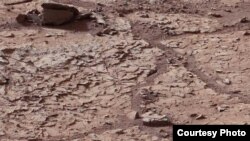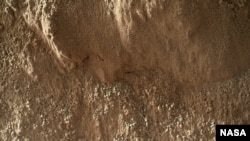SYDNEY —
Academics, miners and space industrialists are gathering in Sydney Wednesday to discuss the possibilities and logistics of mining other planets. Scientists argue that they will eventually overcome the huge expenses and technical difficulties of extracting minerals from asteroids, and even the Moon or Mars.
Could a future mining boom be literally out of this world? That is the question posed by scientists meeting in Sydney, who have their sights firmly set on exploring space for new riches. Asteroids could yield platinum and diamonds, while the moon contains "rare-earth" minerals used to make computers, missiles and wind turbines, which are in increasingly short supply here on Earth.
As it stands, these bold visions are not economically viable, but researchers believe that remote-controlled mining of the Moon might only be a decade away. In the future, other academics say that Mars could also be exploited in the search for valuable minerals.
Gordon Roesler, a space robotics specialist at the University of New South Wales, says the race to extract these hidden treasures has already begun.
“It is interesting there are two companies that have just started up, one in the U.S. and one in the U.K., and they have both said ‘We are going to mine asteroids,’" he said. "Now, we have been talking about this for decades, but why [are] these companies starting now backed by billionaires - why are they doing that? I think it is because of the progress in robotics.
Roesler says robots’ potential is demonstrated by their utility in factories, in undersea exploration as well as on Mars, where NASA’s Curiosity Rover recently deployed its drill on the Red Planet for the first time.
“Those are things that we really could not prove were going to be viable, 20 years ago," he said. "Now, they are so these companies are saying 'well, we will make a long-term play’.”
René Fradet, the deputy director of engineering & science directorate at the U.S. Jet Propulsion Laboratory, was one of the keynote speakers at the conference at the University of New South Wales. He says the Mars Rover’s success will boost the exploration of space.
“I think Curiosity just last week, we performed our first drill, execute a hole on the surface of Mars. So, it is kind of the first step of mining. So, I think we can share some of the experience and lessons learned in executing those kinds of missions and give people a bit of an appreciation for what it takes to make these things happen,” he said.
As well as the pursuit of rare minerals, celestial mining could also be the first step in the colonization of space, where water extracted from asteroids, the Moon or Mars could power spacecraft and sustain human populations.
Delegates at the Sydney conference are discussing a range of innovative technologies and new ways of thinking, both of which will be needed, along with vast amounts of money, if the mining industry is eventually to conquer space.
Curiosity explores Mars
Could a future mining boom be literally out of this world? That is the question posed by scientists meeting in Sydney, who have their sights firmly set on exploring space for new riches. Asteroids could yield platinum and diamonds, while the moon contains "rare-earth" minerals used to make computers, missiles and wind turbines, which are in increasingly short supply here on Earth.
As it stands, these bold visions are not economically viable, but researchers believe that remote-controlled mining of the Moon might only be a decade away. In the future, other academics say that Mars could also be exploited in the search for valuable minerals.
Gordon Roesler, a space robotics specialist at the University of New South Wales, says the race to extract these hidden treasures has already begun.
“It is interesting there are two companies that have just started up, one in the U.S. and one in the U.K., and they have both said ‘We are going to mine asteroids,’" he said. "Now, we have been talking about this for decades, but why [are] these companies starting now backed by billionaires - why are they doing that? I think it is because of the progress in robotics.
Roesler says robots’ potential is demonstrated by their utility in factories, in undersea exploration as well as on Mars, where NASA’s Curiosity Rover recently deployed its drill on the Red Planet for the first time.
“Those are things that we really could not prove were going to be viable, 20 years ago," he said. "Now, they are so these companies are saying 'well, we will make a long-term play’.”
René Fradet, the deputy director of engineering & science directorate at the U.S. Jet Propulsion Laboratory, was one of the keynote speakers at the conference at the University of New South Wales. He says the Mars Rover’s success will boost the exploration of space.
“I think Curiosity just last week, we performed our first drill, execute a hole on the surface of Mars. So, it is kind of the first step of mining. So, I think we can share some of the experience and lessons learned in executing those kinds of missions and give people a bit of an appreciation for what it takes to make these things happen,” he said.
As well as the pursuit of rare minerals, celestial mining could also be the first step in the colonization of space, where water extracted from asteroids, the Moon or Mars could power spacecraft and sustain human populations.
Delegates at the Sydney conference are discussing a range of innovative technologies and new ways of thinking, both of which will be needed, along with vast amounts of money, if the mining industry is eventually to conquer space.
Curiosity explores Mars











